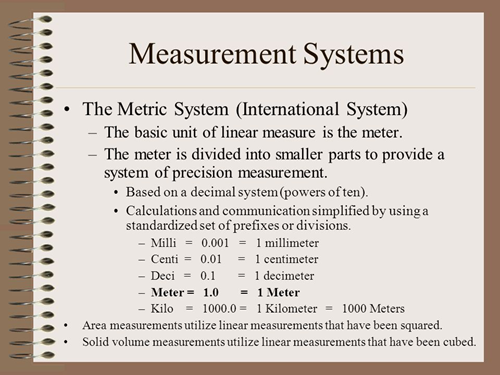Unit 4: Lesson 4: Systems of Measurement
Lesson 4: Systems of Measurement

Lesson 4: Systems of Measurement
Imagine that you are giving a patient medication. What might happen if you calculated the dosage wrong? Measurement and calculations are essential skills in many health science careers. One reason is that giving a patient the wrong dose of a medication could kill them. However, many of us are not always as familiar with measurement systems as we could be, particularly when we might need to convert a number from one type of measurement to another.
A system of measurement is simply a standardized way of characterizing something. Most of you will be familiar with measurements already since we use them when we drive cars (through the speedometer) or take medications (in a measured dose). However, a range of measurements can be found within the healthcare system, particularly in the United States. Medication doses or other measurements may be in US customary or metric units. Let's take a look at each of these systems.

The US customary unit measurement system is commonly used in the United States, although most other countries use the metric system. This system of measurement developed from British Imperial units. It is also sometimes referred to as household measurement since some measurement units were based on items commonly found in the home. In the health sciences, measurements are common for fluid volume. For example, some medications require a tablespoon or a teaspoon dosage. The US fluid ounce, pints, quarts, cups, and gallons also may be used for different health science measurements. In addition, we may measure a patient's weight in pounds and read body temperature in degrees Fahrenheit.
The metric system is more commonly used around the rest of the world. The metric system is a decimalized system of measurement that originated in France. Some professional fields in the United States use the metric system, including some health science fields, and the system is used in most other countries. The metric system uses a series of base units and prefixes with the power of ten. For example, the prefix kilo- indicates that the measurement is multiplied by 1,000 from the original base unit. The base units of the metric system include liters (or liters in the US) for liquid volumes, grams for mass, and so on.
Health science professionals often abbreviate the measurement units in US customary measurements or metric ones. Here are some standard medical measurement unit abbreviations:
| Abbreviations of Medical Units | |
| oz |
|
| fl. oz |
|
| t or tsp |
|
| T or tbsp |
|
| g |
|
| kg |
|
| mg |
|
| mcg |
|
| L or l |
|
| cl |
|
| ml |
|
| µl |
|
